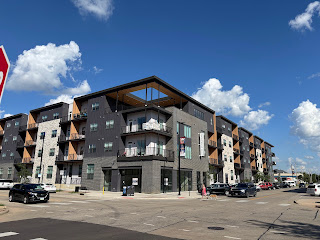 |
| Source: Wikimedia commons |
Cleveland, Ohio, has had as tough a time as any American city making the transition from the industrial to the post-industrial era. During the decade 2005-2015, when many observers saw a return to urban centers by both residents and businesses, Cleveland's population actually dropped by 14.2 percent, more than any large city except for Detroit and New Orleans. On key indicators of community well-being, Cleveland's percentage of adults with a bachelor's degree or higher (15.8), median household income ($26150), and percentage of adults in the labor force (58.2) score well below the U.S. as a whole, and below even comparable cities like Chicago, Milwaukee and Pittsburgh. This has occurred despite the presence of "eds and meds" led by the world-renowned Cleveland Clinic, the city's largest employer.
The City of Cleveland has maintained a lot of the downtown architecture from its heyday, while trying to open up access to Lake Erie. The Terminal Tower was built in 1930 as transportation hub and commercial space, overlooking Public Square:
Inside views:
Public Square is a pedestrian plaza, managed by the mayorally-appointed Group Plan Commission. Beginning in 2011 and dedicated in 2016, the remade Public Square was the first project for the commission, though the new young trees provided little protection from the Sun on the hot day we visited:
 |
| Public Square in 1920. Source: Wikipedia |
Across Public Square from the Tower Center is the Old Stone (First Presbyterian) Church, built in 1855 though Presbyterians have been worshiping on this corner since 1819:
The view down Ontario Street towards the courthouse:
On the other end of the visual delight spectrum, the view down Prospect Avenue towards the Tower Center. Casinos are not civic buildings:
Along Rockwell Avenue, a sign of difficult walking. If the design cues are saying "Cross here," a lot of good a sign is going to do.
The Cleveland Public Library is two blocks from Public Square down Superior Street. Its new Louis Stokes Wing sits nicely next to the original facility, and has some quiet spaces inside...
...while the Eastman Reading Garden between them made for a shady parklet, popular on this sunny summer day.
The commercial areas around the city center feature a lot of massive buildings, historic but not enough variety to be inviting. An exception was East 4th Street, a narrow street closed to traffic and featuring a number of popular gathering places:
The Arcade, a proto-mall dating from 1890, by contrast was rather quiet even on a hot day. Its architecture is impressive...
...but shops like this might have been busier with street access.
North of downtown is Lake Erie. There's enough car traffic to make walking tricky; the Group Plan Commission plans a pedestrian bridge which may help. Attractions (besides the lake) include the home field for the NFL's Cleveland Browns (at left)...
...the Great Lakes Science Science Center...
...and the Rock 'n' Roll Hall of Fame.
We went east via rapid transit to visit the Cleveland Museum of Art. There's some transit-oriented development happening by the new Little Italy stop....
...bringing new people to a charming, walkable neighborhood.
The Cozad-Bates House, build in 1853
Even "star" cities struggle with issues of concentrated poverty, gentrification, infrastructure and so on. Cleveland's struggle to catch up to the post-industrial world exacerbating all those other struggles. A whirlwind tour of the city shows it has good bones in many places, civic attractions that are well-supported, a powerful if mixed heritage, and efforts towards promoting walkability. In theory all a city can do is lay the groundwork for prosperity and then the private sector takes over. What does it do when step one doesn't seem to be working?
(Or maybe it is starting to work? This article in Cleveland Magazine documents a dramatic change in attitude among Cleveland residents towards their home city. Those interviewed for the article seem to put unwarranted faith in attitude and branding as keys to success, but do I have a better answer?)
SEE ALSO:
"Can Cities Change Their Luck," 20 June 2016
"Two Tales of Cities," 7 June 2016
All things Cleveland at cleveland.com
Sheehan Hannan, "Who Are We Now," Cleveland Magazine, 1 July 2017


























No comments:
Post a Comment